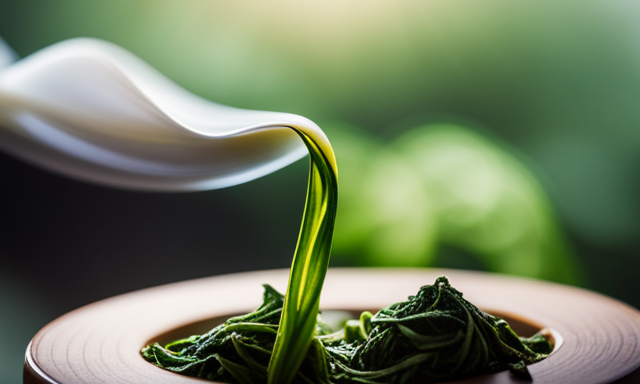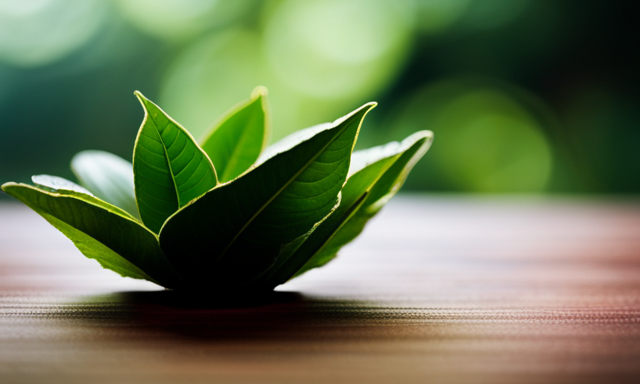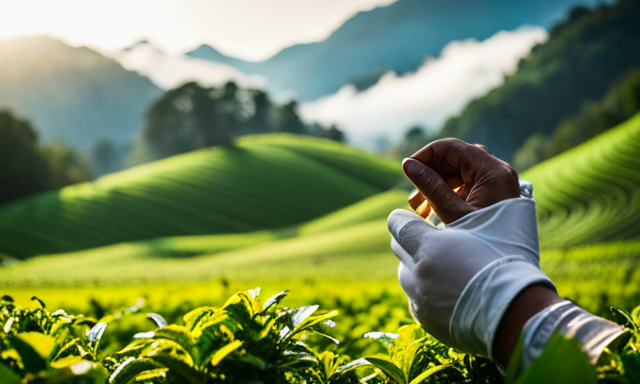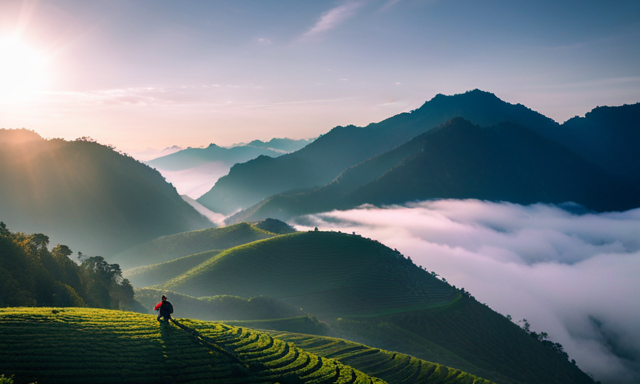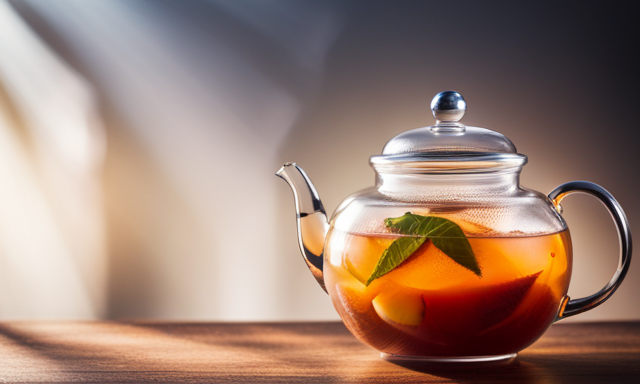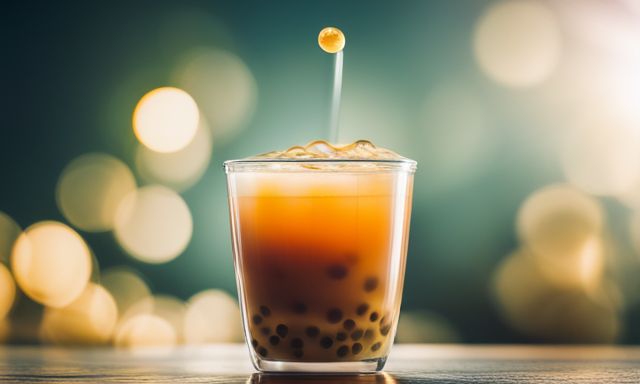Did you know that tea is the second most consumed beverage in the world, second only to water? As a tea enthusiast, I have always been fascinated by the diverse range of flavors and health benefits that different types of tea offer. In particular, oolong and green tea have gained significant popularity for their unique characteristics.
In this article, we will explore the question of which is better: oolong or green tea?
Both oolong and green tea have their own origins, processing methods, and distinct flavor profiles. Oolong tea, with its partially oxidized leaves, boasts a complex and robust taste, while green tea, made from unoxidized leaves, offers a refreshing and grassy flavor. Additionally, each type of tea has its own set of health benefits and varying levels of caffeine content.
By delving into the origins, flavor profiles, health benefits, and brewing techniques of oolong and green tea, we aim to provide you with the necessary information to make an informed decision on which tea suits your preferences and lifestyle.
So, grab a cup of tea, sit back, and let’s explore the world of oolong and green tea together.
Key Takeaways
- Oolong tea contains less caffeine compared to green tea.
- Oolong tea stimulates the central nervous system, enhances alertness and cognitive function, and reduces the risk of chronic diseases.
- Oolong tea should be brewed with water around 195°F (90°C) and steeped for 3 to 5 minutes.
- Oolong tea offers a smooth and complex taste with floral, fruity, or toasty notes.
The Origins and Processing of Oolong Tea
Oolong tea is a unique blend of both the oxidation process of black tea and the non-oxidation process of green tea. This results in a flavor profile that is truly one-of-a-kind.
The origins of oolong tea can be traced back to the mountains of China, where it has been cultivated for centuries.
The processing of oolong tea involves withering the leaves under the sun, then gently bruising and partially oxidizing them. Skilled artisans carefully monitor the oxidation levels to achieve the desired flavor. The partially oxidized leaves are then pan-fired or baked to stop the oxidation process.
The result is a tea that has a complex and floral aroma, with a smooth and mellow taste.
Moving on to the origins and processing of green tea, it is important to understand the distinct characteristics that set it apart from oolong tea.
The Origins and Processing of Green Tea
Originating in East Asia, green tea undergoes a meticulous production process that involves steaming or pan-frying the leaves to preserve their natural flavors and health benefits. The origins of green tea can be traced back to ancient China, where it was first cultivated and consumed for its medicinal properties.
Traditional processing techniques for green tea vary, but they all aim to prevent oxidation, which gives the tea its distinctive green color and delicate flavor. After plucking, the leaves are quickly heated to halt enzymatic activity and then shaped and dried. This careful processing method helps retain the tea’s fresh and grassy taste, as well as its high levels of antioxidants and beneficial compounds.
Transitioning into the subsequent section about the flavor profiles and aromas of oolong tea, one can appreciate the intricate differences between these two teas.
Flavor Profiles and Aromas of Oolong Tea
With its diverse flavor profiles and enticing aromas, oolong tea has captivated tea enthusiasts worldwide, making it the second most consumed type of tea globally after black tea. Oolong tea offers a wide range of flavor pairings, from floral and fruity to toasty and nutty. Its taste varies depending on the oxidation level, with lighter oolongs having a delicate, sweet, and floral flavor, while darker oolongs exhibit a richer, roasted, and earthy taste.
The aroma of oolong tea is equally intriguing, ranging from floral and honey-like to woody and caramel-like. To fully appreciate its flavors, oolong tea requires precise steeping techniques, such as using water at the right temperature and steeping for the appropriate duration. This attention to detail ensures a well-balanced and flavorful cup.
Transitioning to the next section, the flavor profiles and aromas of green tea are equally fascinating.
Flavor Profiles and Aromas of Green Tea
To fully appreciate the flavors and aromas of green tea, you’ll find yourself transported to a serene garden. Delicate notes of grass, seaweed, and fresh spring buds dance on your taste buds. The distinct flavor profile of green tea brings a refreshing and invigorating experience that is unmatched.
Its light and vegetal taste is accompanied by a subtle sweetness and a hint of bitterness, creating a harmonious balance on the palate.
Green tea offers a myriad of health benefits. It boosts metabolism, aids in weight loss, and improves brain function. Its antioxidants help fight off free radicals, reducing the risk of chronic diseases. Additionally, green tea supports heart health and lowers the risk of certain cancers.
Transitioning to the subsequent section, let’s now explore the health benefits of oolong tea.
Health Benefits of Oolong Tea
Indulge yourself in the surprising health benefits of oolong tea, and you’ll be amazed at how this delicious beverage can boost your metabolism and help you shed those extra pounds.
Oolong tea has been known for its potential to aid in weight loss. It contains polyphenols that activate enzymes responsible for dissolving triglycerides, a type of fat stored in our bodies. These enzymes enhance fat metabolism and can help reduce body weight.
Additionally, oolong tea has shown promising effects on diabetes management. It can help regulate blood sugar levels by improving insulin sensitivity. Studies have found that consuming oolong tea regularly can lower the risk of developing type 2 diabetes.
As we delve into the health benefits of green tea, we’ll discover even more remarkable advantages for our well-being.
Health Benefits of Green Tea
Green tea offers numerous health benefits. One key benefit is its ability to boost brain function and enhance mental alertness. The antioxidants in green tea improve cognitive function, focus, and concentration.
Regular consumption of green tea is linked to a lower risk of heart disease and certain types of cancer. The polyphenols in green tea reduce cholesterol levels and protect against heart-related conditions.
Green tea also has powerful anti-cancer properties. The catechins in green tea help prevent the growth and spread of cancer cells.
These health benefits make green tea a remarkable beverage.
Boosting Brain Function and Mental Alertness
Improve your cognitive abilities and stay sharp with a cup of oolong tea. While green tea is often praised for its health benefits, oolong tea also has its own unique advantages when it comes to boosting brain function and mental alertness.
Oolong tea contains caffeine and L-theanine, which work together to improve memory and enhance cognitive function. The caffeine provides a natural energy boost, improving focus and alertness, while the L-theanine promotes relaxation and reduces anxiety, allowing for better concentration.
Additionally, oolong tea contains antioxidants that protect brain cells from damage and support overall brain health. By incorporating oolong tea into your daily routine, you can enhance your cognitive performance and maintain mental clarity.
As we delve into the next section about lowering the risk of heart disease and cancer, we will further explore the incredible benefits of oolong tea.
Lowering the Risk of Heart Disease and Cancer
Protect your heart and fight against cancer by incorporating the powerful benefits of oolong tea into your daily routine.
Oolong tea is packed with antioxidants that can help lower the risk of heart disease and cancer. The high levels of polyphenols in oolong tea play a crucial role in these health benefits. These antioxidants work to neutralize harmful free radicals in the body, preventing cellular damage and reducing the risk of chronic diseases.
Additionally, oolong tea has been found to lower LDL cholesterol levels and improve heart health. The polyphenols in oolong tea also have anti-cancer properties, inhibiting the growth of cancer cells and reducing the risk of various types of cancer.
Transitioning into the subsequent section about caffeine content in oolong and green tea, it’s important to consider the impact of caffeine on our health.
Caffeine Content in Oolong and Green Tea
Enjoy the invigorating and aromatic experience of sipping on a cup of oolong tea, as it infuses you with a gentle boost of natural caffeine. Oolong tea contains caffeine, although in lesser amounts compared to green tea. This makes it a great option for those who are sensitive to caffeine or want to reduce their intake.
The caffeine in oolong tea stimulates the central nervous system, increasing alertness and enhancing cognitive function. Additionally, oolong tea is rich in antioxidants that play a crucial role in protecting the body against oxidative stress and reducing the risk of chronic diseases like heart disease and cancer. So, with oolong tea, you not only get a gentle caffeine kick but also the added benefits of antioxidants.
Now, let’s delve into the art of brewing techniques for oolong tea.
Brewing Techniques for Oolong Tea
To create a perfect cup of oolong tea, start by steeping the leaves in hot water and allowing them to unfurl, releasing their delicate flavors and aromas. Here are some key factors to consider when brewing oolong tea:
-
Water temperature: Oolong tea is best brewed with water that is around 195°F (90°C). This temperature allows the leaves to fully open up and infuse their flavors into the water.
-
Steeping time: The ideal steeping time for oolong tea varies depending on the specific type of oolong and personal preference. Generally, it ranges from 3 to 5 minutes. Longer steeping times can result in a stronger flavor profile.
-
Multiple infusions: Oolong tea leaves can be steeped multiple times. Each infusion brings out different nuances in flavor. Adjust the steeping time accordingly for subsequent infusions.
-
Experimentation: Feel free to experiment with water temperature and steeping time to find your preferred taste profile.
With these techniques, you can savor the rich flavors and aromas of oolong tea.
Now, let’s dive into the brewing techniques for green tea.
Brewing Techniques for Green Tea
When it comes to brewing techniques for green tea, there are two key points to consider: water temperature and steeping time.
Green tea is delicate and can easily become bitter if steeped for too long or with water that is too hot. To achieve a smooth and flavorful cup, I recommend using water that is around 175°F (80°C) and steeping the tea for no more than 2 minutes.
In addition to water temperature and steeping time, the choice of tea ware and infusion method can also impact the taste of green tea. Using a teapot with a built-in strainer or a tea infuser can ensure that the leaves have enough room to unfurl and release their flavors.
Overall, by paying attention to these brewing techniques, you can enjoy a delicious and well-balanced cup of green tea.
Water Temperature and Steeping Time
Don’t even think about steeping your oolong or green tea for too long, or you’ll end up with a bitter brew. The water temperature and steeping time play a crucial role in determining the flavor and aroma of your tea.
For green tea, it is recommended to use water at around 175°F (80°C) and steep it for about 2-3 minutes. This lower temperature helps preserve the delicate flavors and prevents the tea from becoming overly bitter.
Oolong tea, on the other hand, benefits from slightly hotter water, around 190-200°F (88-93°C), and a slightly longer steeping time of 3-5 minutes. This allows the tea leaves to unfurl and release their complex flavors and aromas.
Now that we’ve covered water temperature and steeping time, let’s move on to discussing tea ware and infusion methods.
Tea Ware and Infusion Methods
Get ready to discover the perfect tea ware and infusion methods that will elevate your tea-drinking experience to a whole new level!
When it comes to enjoying oolong or green tea, the right tea ware and infusion methods can make all the difference.
Firstly, let’s talk about tea ware. For oolong tea, a porcelain or clay teapot is ideal, as it helps to retain heat and enhance the tea’s flavors.
Green tea, on the other hand, is best brewed in a glass teapot, allowing you to appreciate its vibrant color.
Now, let’s move on to infusion methods. For oolong tea, a longer steeping time of around 3-5 minutes is recommended to extract its complex flavors.
Green tea, on the contrary, requires a shorter steeping time of about 2-3 minutes to prevent bitterness.
With the right tea ware and infusion methods, you’ll be able to fully appreciate the unique characteristics of each tea.
So, now that you know the ins and outs of tea preparation, it’s time to make your choice: oolong or green tea?
Making Your Choice: Oolong or Green Tea?
To make your choice between oolong and green tea, you’ll want to consider the fact that oolong tea contains on average 36 milligrams of caffeine per cup, while green tea contains around 29 milligrams.
Both oolong and green tea offer distinct flavors and aromas, so it’s important to compare them before making the right choice for you.
Oolong tea is known for its smooth and complex taste, often described as a balance between black and green tea. It can have floral, fruity, or toasty notes, depending on the variety.
On the other hand, green tea has a fresh and grassy flavor with a slightly vegetal or seaweed undertone. Its aroma is often described as vegetal or nutty.
Ultimately, the decision between oolong and green tea comes down to personal preference and the flavor profile that appeals to you the most.
Frequently Asked Questions
How many cups of oolong tea should I drink per day for maximum health benefits?
I recommend limiting oolong tea intake to 2-3 cups per day for optimal health benefits. It contains less caffeine compared to green tea, reducing potential side effects while still providing antioxidants and promoting weight loss.
Can green tea help with weight loss?
Green tea can be an effective pre-workout supplement for weight loss due to its ability to boost metabolism. Its natural compounds, like catechins, can increase fat oxidation and improve exercise performance.
Does oolong tea have a higher caffeine content than green tea?
Yes, oolong tea does have a higher caffeine content than green tea. While both teas offer health benefits, oolong provides a more energizing effect due to its higher caffeine levels.
What are the different flavor profiles of oolong and green tea?
Oolong tea and green tea have distinct flavor profiles. Oolong tea is known for its rich, fruity, and floral notes, while green tea has a grassy, fresh taste. Both teas offer various health benefits, including antioxidants and potential weight management support.
Are there any specific brewing techniques that enhance the taste of oolong tea?
One interesting statistic is that using a gongfu brewing technique for oolong tea can bring out its complex flavors. This method involves multiple short infusions, resulting in a rich and aromatic taste that enhances the tea’s overall experience.
Conclusion
After exploring the origins, flavor profiles, health benefits, caffeine content, and brewing techniques of both oolong and green tea, it is clear that choosing between the two is like deciding between a serene walk in a lush garden or a refreshing dip in a crystal-clear lake.
Both teas have their own unique qualities and offer a delightful sensory experience. Ultimately, the decision comes down to personal preference and the specific benefits one seeks.
Whichever path you choose, both oolong and green tea will surely transport you to a world of tranquility and rejuvenation.

